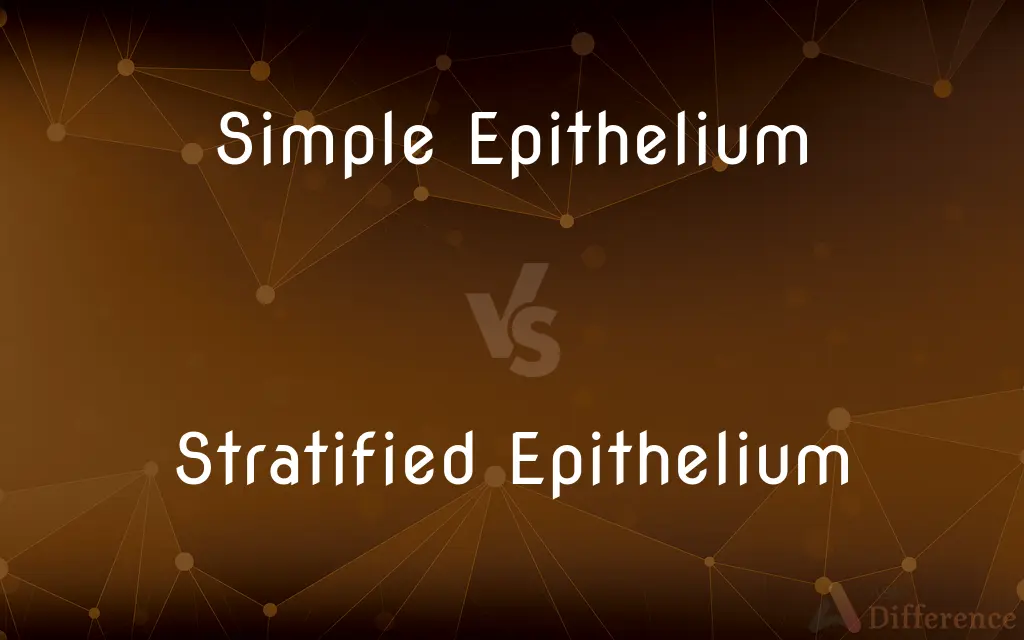Simple Epithelium vs. Stratified Epithelium — What's the Difference?
By Tayyaba Rehman — Published on December 26, 2023
Simple Epithelium has a single layer of cells, while Stratified Epithelium consists of multiple cell layers; both are tissue types covering body surfaces.

Difference Between Simple Epithelium and Stratified Epithelium
Table of Contents
ADVERTISEMENT
Key Differences
Simple Epithelium is a type of tissue that consists of a single layer of cells. These cells are uniform and are in direct contact with the basement membrane. On the other hand, Stratified Epithelium is characterized by multiple layers of cells stacked upon each other. This layering provides an added level of protection and durability to the tissue.
In the body, Simple Epithelium primarily plays a role in secretion, absorption, and filtration. Because of its thinness, substances can pass through it easily. In contrast, Stratified Epithelium is more robust and resilient. It's mainly found in areas of the body subjected to wear and tear, where its multilayered structure offers protection against abrasion and injury.
Functionally, Simple Epithelium is found in areas where rapid diffusion or transport of substances is required. Examples include the lining of blood vessels and lung alveoli. Stratified Epithelium, with its multiple cell layers, is more suited for protective roles and is predominantly found in areas such as the skin, the mouth, and the esophagus.
An interesting difference between Simple Epithelium and Stratified Epithelium is their capability to regenerate. Both types have regenerative abilities, but because Stratified Epithelium is located in areas prone to damage, its cells often have a faster turnover rate. In contrast, cells in Simple Epithelium may not need to regenerate as quickly due to their protected locations.
Comparison Chart
Number of Layers
Single layer of cells.
Multiple layers of cells.
ADVERTISEMENT
Function
Secretion, absorption, filtration.
Protection against wear and tear.
Location Examples
Lining of blood vessels, lung alveoli.
Skin, mouth, esophagus.
Regeneration Rate
Might have slower turnover due to location.
Faster turnover due to damage-prone areas.
Contact with Basement Membrane
Direct contact.
Only the bottom layer is in direct contact.
Compare with Definitions
Simple Epithelium
A uniform tissue layer primarily found in protected body areas.
The inner surface of the eye is covered by Simple Epithelium.
Stratified Epithelium
Multilayered tissue providing protection against abrasion.
The mouth's lining is Stratified Epithelium, which guards against mechanical injury.
Simple Epithelium
Epithelial tissue directly in contact with the basement membrane.
The lining of kidney tubules is Simple Epithelium, playing a role in filtration.
Stratified Epithelium
Tissue found in areas prone to wear and tear.
Stratified Epithelium in the skin sheds and regenerates frequently due to external stresses.
Simple Epithelium
A tissue composed of a single layer of cells.
The alveoli in the lungs are lined with Simple Epithelium to facilitate gas exchange.
Stratified Epithelium
Epithelial tissue where only the bottom layer contacts the basement membrane.
In the esophagus, Stratified Epithelium prevents damage from ingested food.
Simple Epithelium
A single-cell layer tissue involved in absorption and secretion.
The intestines have Simple Epithelium that aids in nutrient absorption.
Stratified Epithelium
A tissue composed of multiple cell layers.
The outer layer of our skin is Stratified Epithelium, protecting against environmental damage.
Simple Epithelium
A thin tissue layer allowing rapid diffusion or transport.
Blood vessels' inner lining consists of Simple Epithelium to promote efficient nutrient exchange.
Stratified Epithelium
A robust tissue type with a high regenerative capacity.
The vagina's lining, made of Stratified Epithelium, can regenerate quickly after injury.
Common Curiosities
Why might Stratified Epithelium have a faster cell turnover rate?
Because it's found in damage-prone areas, it regenerates more rapidly for protection.
How does the thickness of Simple Epithelium compare to that of Stratified Epithelium?
Simple Epithelium is thinner with one cell layer, while Stratified Epithelium is thicker with multiple layers.
How does Stratified Epithelium differ from Simple Epithelium in structure?
Stratified Epithelium has multiple cell layers, while Simple Epithelium consists of just one layer.
In which body areas is Stratified Epithelium commonly located?
Stratified Epithelium is often in areas prone to wear, such as the skin, mouth, and esophagus.
What is the primary purpose of Stratified Epithelium?
The primary function of Stratified Epithelium is to provide protection against physical wear and injury.
Where might you commonly find Simple Epithelium in the body?
Simple Epithelium is typically found in protected areas like blood vessel linings and lung alveoli.
Which type of epithelium facilitates rapid diffusion?
Simple Epithelium, due to its thinness, facilitates rapid diffusion.
What is Simple Epithelium in the context of body tissues?
Simple Epithelium is tissue consisting of a single layer of cells, often involved in secretion and absorption.
Do both Simple Epithelium and Stratified Epithelium contact the basement membrane?
In Simple Epithelium, all cells contact the basement membrane, but in Stratified Epithelium, only the bottom layer does.
Which type of epithelium is typically involved in absorption functions?
Simple Epithelium is more commonly associated with absorption.
Are there areas in the body where both Simple and Stratified Epithelia are found close to each other?
Yes, some regions transition from Simple to Stratified Epithelium, like where the stomach meets the esophagus.
Are there subtypes of Stratified Epithelium?
Yes, Stratified Epithelium has subtypes, such as stratified squamous or stratified columnar, based on cell shape.
Share Your Discovery

Previous Comparison
Strict Liability vs. Absolute Liability
Next Comparison
Single User Operating System vs. Multiuser Operating SystemAuthor Spotlight
Written by
Tayyaba RehmanTayyaba Rehman is a distinguished writer, currently serving as a primary contributor to askdifference.com. As a researcher in semantics and etymology, Tayyaba's passion for the complexity of languages and their distinctions has found a perfect home on the platform. Tayyaba delves into the intricacies of language, distinguishing between commonly confused words and phrases, thereby providing clarity for readers worldwide.
















































